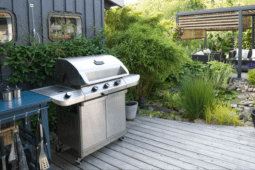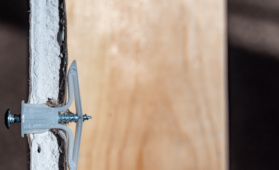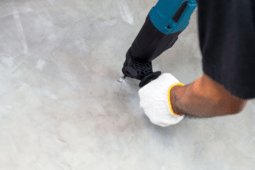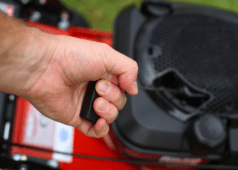How to: Make a DIY Reclaimed Wood Storage Box from a Wooden Block

Making a bandsaw box is a great starter project for learning how to expand your talents in the shop. Just a few steps transforms a block into a great desktop or nightstand box. I had a used block sitting around from another project, and this just seemed like a natural way to make it into something useful. For this project, I used a piece of wood still around from my recent pallet projects. I love the stamping, used texture and random nails in the block, so I really wanted to find a small project that would make it something interesting for my office. Because it is reclaimed wood, it's full of natural flaws like a few cracks and knots that give it a lot more character than a fresh piece of wood (I was going for something natural to match up to my reclaimed charger block, so I minimized the sanding and aged the hardware to maximize the rough look). I always misplace my keys/wallet/brain while I'm trying to get out of the office at quitting time, so a small box is the perfect landing spot when I walk up to my desk in the morning.
![credit: David [] Bandsaw Box](https://s3.amazonaws.com/manmadediy-uploads-production/photos/25058/IMG_8350_large.jpg?1426486075) First thing, be aware that pallet wood can be full of random chemicals, metal, and other mystery items thanks to it's previous life so work in well ventilated areas with plenty of dust collection. Plan on running through a few nails/staples, so it's best to use your junk blades if possible.
First thing, be aware that pallet wood can be full of random chemicals, metal, and other mystery items thanks to it's previous life so work in well ventilated areas with plenty of dust collection. Plan on running through a few nails/staples, so it's best to use your junk blades if possible.![credit: David [] Finished Box](https://s3.amazonaws.com/manmadediy-uploads-production/photos/25060/DSC_0151_large.jpg?1426486259)
Heres a quick material and tool list for the project:
Materials:
- 1 block of wood (mine was approx. 4″x4″x6) Grain should run the length of the box.
- 2 hinges (I originally used small galvanized hinges, but re-finished them with a blowtorch for a more blackened look)
- 1 small piece of material for a lining (optional, but it's a nice finish touch)
Tools:
- Table saw or hand saw (for cutting top and bottom off, then lid off at the end)
- Bandsaw (for cutting out the center)
- Sander (optional, you can use your muscle instead)
- Chisel/Dremel tool
![credit: David [] Cutting Top Off Box](https://s3.amazonaws.com/manmadediy-uploads-production/photos/25061/IMG_8326_large.jpg?1426486327) Step 1) Starting with the wood – The block should be square with parallel flat faces. Look for any nails or other metal that may be an issue when cutting. Decide what face should be the top, and mark it with a small x if necessary. My top had writing on it from it's previous life so marking was not necessary. Mark both sides with chalk or pencil from the top to bottom so they can be properly re-aligned later – this is very important, as the pieces have to match up exactly when putting it all back together.
Step 1) Starting with the wood – The block should be square with parallel flat faces. Look for any nails or other metal that may be an issue when cutting. Decide what face should be the top, and mark it with a small x if necessary. My top had writing on it from it's previous life so marking was not necessary. Mark both sides with chalk or pencil from the top to bottom so they can be properly re-aligned later – this is very important, as the pieces have to match up exactly when putting it all back together.
![credit: David [] Top Cut Off](https://s3.amazonaws.com/manmadediy-uploads-production/photos/25062/IMG_8327_large.jpg?1426486706) Step 2) Set the tablesaw for 1/8″ – 1/4″ depending on how thick the top should be. On smaller boxes, 1/8″ is generally enough, but if the wood is a bit weathered with cracks or knots it's safer to make it thicker. Be sure the blade is aligned to 90 degrees for a straight cut. After the saw is set, run the block through to cut off the top and bottom. I generally cut this step in 2 steps, cutting just over half the thickness then flipping the piece and slicing the other half. You should end up with a block of wood that has two matching pieces for the top and bottom.
Step 2) Set the tablesaw for 1/8″ – 1/4″ depending on how thick the top should be. On smaller boxes, 1/8″ is generally enough, but if the wood is a bit weathered with cracks or knots it's safer to make it thicker. Be sure the blade is aligned to 90 degrees for a straight cut. After the saw is set, run the block through to cut off the top and bottom. I generally cut this step in 2 steps, cutting just over half the thickness then flipping the piece and slicing the other half. You should end up with a block of wood that has two matching pieces for the top and bottom.
![credit: David [] Band Saw Cuts](https://s3.amazonaws.com/manmadediy-uploads-production/photos/25063/IMG_8330_large.jpg?1426486782)
Step 3) On the main block of wood, mark out the outline that you want for the inside of the box. when cutting with the bandsaw, curves are expected, so feel free to get a bit creative on the design. I didn't switch out my large blade, so I was limited in my design and I had to drill holes in the corners to allow for the blade to spin properly. Also, don't make the walls of the box too thin as this will compromise strength when installing hinges or sanding.
![credit: David [] Body Cut Out Box](https://s3.amazonaws.com/manmadediy-uploads-production/photos/25064/IMG_8338_large.jpg?1426486832)
Step 4) With the design laid out, start the cut. Bandsaw boxes have a cut through the back into the middle, so slice a cut in from the back and start hogging out the material. Go slow to maintain a straight blade (cut). Slice out the material in small pieces and remove it frequently to be able to see and avoid binding up of the blade. I ran into a few nails that chipped my blade a bit, but after about 20 minutes I had all the materials cut out and a bit of rough smoothing done. I decided to keep the shape organic for visual interest.
![credit: David [] Top and Bottom Box](https://s3.amazonaws.com/manmadediy-uploads-production/photos/25065/IMG_8340_large.jpg?1426486895)
Step 5) Now that the box center was cut out, I used a small sanding head on my Dremel tool and a bit of hand sanding to get the inside smooth. Go especially easy on the back because the back cut can be delicate at this time. Once the interior is smoothed out enough, grab the top and bottom cut off in Step 2. This is why the chalk was important, because with proper marking the pieces should be easy to match back up into a block again.
![credit: David [] Gluing Box Together](https://s3.amazonaws.com/manmadediy-uploads-production/photos/25066/IMG_8348_large.jpg?1426486951)
Step 6) With all of the pieces matched up, spread a nice layer of glue on the edges and clamp it together to glue it back into a single block. Don't use too much glue to the point that there's excessive squeeze-out on the inside, it's impossible to clean that up without a huge amount of hassle later on. Let the glue dry for at least a few hours, but overnight is better.
![credit: David [] Cutting Top off Box](https://s3.amazonaws.com/manmadediy-uploads-production/photos/25067/IMG_8350_large.jpg?1426487005)
Step 7) With the block properly glued back up, it's time to cut the top (just the top) back off. Set up the tablesaw to slice the top back off, but also set it to cut about 1/8″ of the side as well. This extra bit adds a nice touch (and reinforcement) to the top. *depending on your blade, a table saw “kerf” is about 1/16″ – 1/8″. This is the amount of wood the saw basically eats during a cut. Make sure to account for this when setting up the cut for the top. Just like in step 2, cut the top off in two passes. This should result in a matched box top.
![credit: David [] Hinges](https://s3.amazonaws.com/manmadediy-uploads-production/photos/25068/DSC_0177_large.jpg?1426487077)
Step 8) Install the hinges by putting a piece of paper between the top and body of the box and using a few spring clamps to hold the lid aligned to the rest of the box. Take the hinges and line them up on the back of the box, then outline them with a blade of pencil. Using a chisel or Dremel tool, chip out a space for the hinges to sit flush with the back surface. When this is finished, paint or stain the pieces and then assemble. The back of my box was a bit thin, so the screws I used to install the top went through – I cut them off with a cutting blade on my Dremel tool.
![credit: David [] Close-Up Inside](https://s3.amazonaws.com/manmadediy-uploads-production/photos/25069/DSC_0183_large.jpg?1426487164)
Step 9) That should leave you with a finished box. A few things that can be done to give it some final character are a small liner, and a jewelry box chain to keep the top from falling back. I added a liner in by cutting a small piece of vinyl and gluing down with spray adhesive, and by skewing one of the hinges slightly the box stays up through friction. Another thing I did was weather the hinges with a blowtorch to give it a blackened look. To do this, I heated up the pieces until they were glowing red, then added a few drops of lubricant oil to them and rubbed it in with a small rag (caution – don't breathe that lubricant-laden smoke, and glowing metal is hot enough to blister, so act accordingly). Don't forget to blacken the screws as well to make it all match up.![credit: David [] Both Hinges](https://s3.amazonaws.com/manmadediy-uploads-production/photos/25070/DSC_0187_large.jpg?1426487239)
There are plenty of ways to expand on this basic bandsaw box, like adding layers of complimenting wood, small drawers, or even some metal accents. So go try out this project and let me know how you make it your own!
![credit: David [] Finished Box](https://s3.amazonaws.com/manmadediy-uploads-production/photos/25071/DSC_0151_large.jpg?1426487349)









